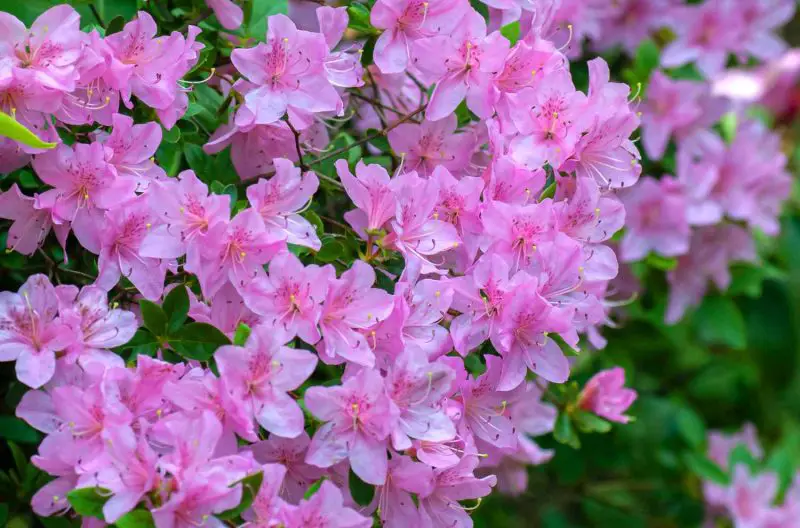Azaleas are among the most beloved flowering shrubs, known for their spectacular springtime displays and the ability to add vibrant color to gardens of all sizes. To know when to prune azalea, it is essential to first understand how these plants grow and bloom. Most azaleas produce their flower buds in the previous growing season, which means that pruning at the wrong time could remove the buds and result in fewer flowers the next year.
These shrubs typically have a natural, rounded growth habit, but without proper care, they can become leggy or overgrown. By learning their blooming cycle and the best pruning techniques, you can help your azaleas maintain a fuller shape while encouraging more vigorous growth and healthier blooms.
Why Timing Matters When Pruning Azalea

Pruning azaleas at the correct time is more than just a matter of convenience—it directly impacts the health of the plant, the abundance of blooms, and the overall shape of the shrub. Since azaleas form their flower buds several months before they actually bloom, mistiming your cuts can unintentionally remove the very buds that would have provided the next season’s display. This is why the period right after flowering ends is considered the sweet spot for pruning.
When pruning is done too late in the year, especially in midsummer or fall, you risk cutting off the developing buds for the following spring. This not only leads to fewer flowers but can also disrupt the plant’s natural growth cycle. Conversely, pruning too early, before the current year’s blooms have finished, diverts the plant’s energy away from flowering and into regrowth, leaving the display less impressive.
Correct timing also allows the plant to recover quickly. Azaleas need time after pruning to produce new shoots, strengthen their structure, and prepare for bud setting. If given enough warm-weather weeks, they will respond with healthier, denser foliage and a stronger framework, resulting in better flowering and a fuller shape the next year.
Best Time to Prune Azalea in Different Climates
Pruning in Mild and Warm Climates
In regions where winters are mild and frost is rare, azaleas often enjoy a longer active growing season and a slightly extended bloom period. These favorable conditions can sometimes cause the plants to hold their flowers a bit longer into the season. In such climates, pruning should ideally take place immediately after the last petals fall, typically in late spring or very early summer. Acting within this window ensures the plant can redirect its energy toward producing healthy new shoots and setting buds for the next year’s bloom cycle. If pruning is delayed, even by a few weeks, new buds may already be forming, and cutting them off could reduce flowering potential. Additionally, because warm-climate azaleas may grow more vigorously, shaping the plant during this time helps maintain a balanced, compact form before summer growth accelerates.
Pruning in Cooler Climates
Cooler climates often mean a shorter growing season and later blooms, with some azalea varieties flowering well into early summer. In these regions, timing becomes even more critical because the plant has less time to recover and prepare for winter. Pruning should be carried out as soon as the last flowers fade, taking care not to wait beyond two to three weeks after blooming. A prompt approach gives the shrub enough time to produce new growth and set buds before the weather cools again. Cold winters can put stress on plants. Removing too much foliage can make azaleas more vulnerable to frost damage in dormancy.
Adjusting for Re-Blooming Azalea Varieties
Re-blooming azaleas, like Encore or Bloom-A-Thon, have a unique flowering pattern. They bloom in spring and produce one or more lighter flushes later in the season. For these cultivars, pruning strategy shifts toward minimal disruption. After the main spring bloom, perform light shaping and remove any dead or damaged wood. Between later flushes, focus on selective deadheading rather than heavy pruning. This approach keeps the plant tidy while preserving the buds that fuel the next round of flowers. Avoid substantial cuts late in the growing season—particularly after midsummer—because the plant needs time to strengthen before winter dormancy. In colder areas, this is especially important, as late pruning can encourage tender new growth that will not have time to harden off before frost arrives.
Signs Your Azalea Needs Pruning
Knowing when to prune your azalea is key to keeping it healthy and attractive. A drop in bloom quantity or quality often signals the need for pruning, as older wood can overshadow younger, more productive shoots. A leggy or uneven shape, with bare centers and foliage only at the tips, also indicates it’s time to encourage lower branching for a fuller form.
Look out for dead, damaged, or diseased branches, as these weaken the plant and can spread pests or infections. Overcrowded growth that limits airflow can cause fungal problems like powdery mildew, making selective thinning essential. If the shrub begins to sprawl into paths or other plants, controlled pruning will restore shape and balance. Regular checks and timely action will help your azaleas stay vibrant and blooming year after year.
Pruning at the right moment also prevents small problems from becoming serious. Removing weak or crossing branches early stops damage from wind or rubbing and allows the plant to channel energy into strong, healthy shoots. This simple habit can greatly extend the lifespan of your azalea.
Seasonal changes can influence when signs appear, so observe your plant year-round. For example, yellowing leaves in summer may indicate overcrowding, while brittle stems in winter could be remnants of old wood. By acting quickly when these signs emerge, you keep the shrub in peak condition and ready for the next bloom cycle.
How to Prepare for Pruning
Choosing the Right Tools
Selecting the proper tools is the foundation of successful azalea pruning. Sharp, high-quality tools create clean cuts that heal faster and reduce the chance of infection or dieback. For small, tender stems and light shaping, bypass hand pruners are ideal because they make precise cuts without crushing plant tissue. Loppers, with their longer handles and stronger cutting capacity, are better suited for medium-sized branches that are too thick for pruners. If you are dealing with an older azalea that has developed thick, woody stems, a small pruning saw will give you the leverage and cutting power you need. Investing in ergonomic tools can also reduce hand fatigue during longer pruning sessions, allowing you to work more carefully and avoid mistakes.
Sanitizing Equipment
Cleanliness is just as important as sharpness when it comes to pruning tools. Plant diseases, particularly fungal infections, can easily transfer from one plant to another through contaminated blades. Before starting, wipe your tools with a cloth soaked in rubbing alcohol, or immerse the cutting edges in a diluted bleach solution—about one part bleach to nine parts water. Allow the tools to air dry before using them. If you are pruning multiple plants, re-sanitize your tools between each one to ensure you are not inadvertently spreading pathogens or pests. This extra step only takes a few moments but can save months of plant recovery time later.
Inspecting the Plant
Before making any cuts, spend time observing the azalea from different angles. Identify branches that cross or rub together, as these can cause wounds and invite disease. Pay attention to areas where growth is too dense, which may limit air circulation and light penetration. Also, identify sections with dead, weak, or damaged wood—these should be your first targets for removal. For shaping purposes, envision the form you want the plant to have, whether it’s a natural rounded look or a slightly more structured silhouette. Having a clear pruning plan before you start will help you work more efficiently and avoid removing more growth than necessary.
Step-by-Step Guide to Pruning Azaleas
Step 1: Remove Dead and Damaged Wood
The first and most critical step is to identify and remove any branches that are dead, diseased, or physically damaged. Dead wood can be recognized by its brittle texture, lack of green tissue beneath the bark, and absence of buds or leaves. Diseased wood may show signs such as blackened areas, cankers, or fungal growth. To remove these branches, make a clean cut just above healthy wood or down to the branch collar, the slightly swollen area where the branch meets the trunk or a larger limb. Avoid leaving stubs, as they can become entry points for pathogens. This initial clearing not only improves the plant’s appearance but also redirects the shrub’s energy into supporting vigorous, healthy shoots.
Step 2: Thin Out Overcrowded Branches
Once all dead and damaged wood is removed, shift focus to improving the plant’s internal structure. Overcrowding occurs when too many branches compete for space, especially in the center of the plant. This congestion limits airflow and light penetration, creating conditions favorable to fungal problems like powdery mildew and leaf spot. Identify branches that are growing inward, crossing over others, or rubbing together, as friction can cause bark wounds. Use sharp bypass pruners or loppers to remove these problematic stems entirely, cutting them back to their point of origin rather than just shortening them. This thinning process should be gradual—removing no more than 20–25% of the plant’s total foliage at one time to avoid excessive stress.
Step 3: Shape the Plant
Shaping is where aesthetics meet plant health. To maintain a naturally rounded, balanced form, begin by stepping back and assessing the overall silhouette of your azalea. Long, leggy shoots should be trimmed back to just above a healthy outward-facing bud or lateral branch junction. This technique encourages branching in the desired direction and promotes a fuller shape. Always angle the cut slightly away from the bud to allow water to run off, reducing the risk of rot. Avoid cutting all shoots to the same length—this can create an unnatural, “sheared” look and weaken the plant over time. Instead, stagger your cuts to mimic the shrub’s natural growth pattern.
Step 4: Rejuvenate Older Plants
For mature azaleas that have grown woody, sparse, or misshapen, rejuvenation pruning can breathe new life into the shrub. This is best done over a two- to three-year period to minimize shock. In the first year, select one-third of the oldest, thickest stems and cut them back to ground level or to a strong basal shoot. This stimulates the growth of fresh, vigorous stems from the base. The following year, repeat the process with another third of the old stems, and complete the cycle in the final year. Between rejuvenation cuts, encourage healthy growth with consistent watering, mulching, and feeding with a slow-release fertilizer formulated for acid-loving plants. Over time, the shrub will develop a denser framework, improved flowering performance, and a rejuvenated appearance.
Common Pruning Mistakes to Avoid
Pruning at the Wrong Time
Timing is critical when pruning azaleas, and getting it wrong can drastically reduce the number of blooms you see the following year. Azaleas set their flower buds almost immediately after they finish blooming. If you prune in midsummer, fall, or even early winter, you are likely cutting off these newly formed buds before they have a chance to mature. The result is a plant that looks green and healthy but produces few or no flowers in the next season. Pruning too early—while the plant is still in bloom—has its own drawbacks. It interrupts the flowering cycle, cutting short the display you waited months to see. The optimal time to prune is within two to three weeks after the last blooms fade. This window ensures you preserve as many buds as possible for the following year. It also gives the plant enough warm months to produce healthy new growth before dormancy.
Removing Too Much Growth at Once
While it can be tempting to cut back an overgrown azalea all at once, doing so can shock the plant and set back its recovery. Removing more than about one-third of the plant’s total foliage in a single pruning session deprives it of the leaf surface needed for photosynthesis, reducing its energy reserves. A sudden loss of foliage can also expose previously shaded branches to intense sunlight, leading to sunscald and dieback. Instead of aggressive, one-time pruning, use a staged approach. If major reshaping is needed, spread the work over multiple seasons—removing a portion of the oldest wood each year—so the plant has time to replenish its energy and maintain steady growth.
Using Dull or Improper Tools
Pruning tools that are dull or poorly maintained do more harm than good. Dull blades tend to crush or tear branches, leaving jagged wounds that heal slowly and are more susceptible to rot, fungal infections, and pest invasion. Similarly, using tools that are too small for thick branches can force you to twist or wrench the branch during cutting, which causes unnecessary damage. To avoid these problems, invest in high-quality bypass pruners for small branches, loppers for medium stems, and a sharp pruning saw for larger, woody growth. Keep blades sharpened regularly and disinfect them before moving from one plant to another to prevent disease spread.
Shaping the Plant Unnaturally
Azaleas naturally grow into a soft, rounded shape, but many gardeners make the mistake of shearing them like hedges to achieve a rigid outline. While this method may look tidy for a short time, it encourages dense growth on the outer edges and leaves the inner branches shaded and bare. Over time, the plant produces fewer flowers inside and can become hollow in the center. Instead of shearing, practice selective thinning by removing individual stems at their base or just above a healthy bud. This method opens up the plant, improves air circulation, and allows sunlight to reach the interior, resulting in more balanced growth and consistent blooming.
Ignoring the Plant’s Overall Health
Pruning should be part of the plant’s full care routine. If the azalea is stressed by poor soil, drought, heat, or pests, avoid heavy pruning. Stress can slow healing and increase disease risk. Before major pruning, improve the plant’s health. Check soil pH to match acid-loving needs. Give deep, regular watering to maintain moisture. Use slow-release fertilizer made for azaleas. Strengthening the plant first will make pruning promote healthy regrowth instead of decline.
Aftercare Following Pruning
Watering and Mulching
Right after pruning, your azalea will channel a significant amount of energy into healing cuts and producing fresh shoots. Deep watering is essential during this period to reduce stress and keep the root system hydrated. Aim to water slowly at the base of the plant, allowing moisture to penetrate 6–8 inches into the soil. This encourages deeper root growth and prevents surface roots from drying out too quickly. Avoid overhead watering, as wet foliage can increase the risk of fungal infections.
Mulching is equally important in post-pruning care. Apply a 2–3 inch layer of organic mulch—such as pine bark, pine needles, or shredded hardwood—around the base of the plant, leaving a few inches of space around the stem to prevent rot. Mulch helps conserve soil moisture, regulate temperature fluctuations, and suppress weeds that would otherwise compete with your azalea for nutrients. In regions with hot summers, mulch acts as insulation, protecting roots from excessive heat stress.
Fertilizing
Pruning stimulates new growth, and to support this process, your azalea will need a nutrient boost. About a week after pruning, apply a balanced, slow-release fertilizer specifically formulated for acid-loving plants, typically with an NPK ratio around 10-10-10 or 12-6-6. This ensures a steady supply of nitrogen for leaf development, phosphorus for root strength, and potassium for overall plant health. Scatter the fertilizer evenly around the drip line of the shrub, not directly at the base, and water thoroughly to help nutrients soak into the root zone. Avoid over-fertilizing, as excessive nitrogen can lead to lush foliage growth at the expense of flower production in the next bloom cycle.
Monitoring for Pests and Diseases
Fresh pruning cuts, while beneficial for growth, can temporarily make the plant more attractive to pests and more vulnerable to disease. Keep a close eye on your azalea in the weeks following pruning for common threats such as lace bugs, spider mites, and azalea caterpillars. Look for signs like stippled or yellowing leaves, webbing, or chewed foliage. For fungal issues, watch for black spots, powdery coatings, or leaf blight.
Early detection is key—minor infestations can often be managed with targeted organic solutions like insecticidal soap or neem oil. In cases where pests are more persistent, selective chemical treatments may be necessary, but these should be used carefully to avoid harming beneficial insects. Maintaining good airflow within the plant through proper pruning, coupled with consistent monitoring, is the best long-term defense against pest and disease problems.
Seasonal Azalea Maintenance Beyond Pruning
Spring Care
Spring marks the height of azalea beauty, with blooms reaching their peak. During this time, your primary task is to maintain optimal growing conditions so the flowers last as long as possible. Keep the soil evenly moist by watering deeply once or twice a week, adjusting based on rainfall. Avoid letting the soil dry out completely, as even short periods of drought can stress the plant and shorten bloom duration.
Once flowering ends, feed your azalea with a slow-release, acid-loving plant fertilizer to replenish nutrients used during blooming. This timing also aligns with the plant’s transition into vegetative growth, ensuring the nutrients fuel new leaf and bud formation. If pruning is necessary—whether for shaping or removing deadwood—do it promptly after blooms fade to avoid cutting off next year’s buds.
Summer Care
In summer, azaleas shift their energy toward producing leaves and setting buds for the following spring. This is a critical phase where consistent moisture is essential, especially during prolonged dry or hot periods. Water early in the morning to minimize evaporation and reduce fungal risk. In hotter climates, providing dappled afternoon shade can prevent leaf scorch and reduce plant stress.
Mulching remains important in summer, as it keeps the soil cooler and retains moisture. Inspect your plants regularly for pests such as lace bugs, spider mites, and caterpillars, which tend to be more active in warmer months. Light deadheading of spent blooms from re-blooming varieties can help maintain plant neatness and encourage repeat flowering.
Fall Care
Fall is a transitional season for azaleas, and the focus should be on preparing the plant for winter rather than encouraging new growth. Avoid applying high-nitrogen fertilizers, as this can trigger soft, late-season growth that is vulnerable to frost damage. Instead, you can apply a light dose of potassium-rich fertilizer to help strengthen roots and improve cold hardiness.
Keep the area around your azalea clear of fallen leaves and plant debris, as these can harbor pests and fungal spores over the dormant season. This is also a good time to check soil pH and adjust if necessary, aiming for a range between 4.5 and 6.0 for optimal nutrient uptake in the coming year.
Winter Care
In winter, especially in colder climates, azaleas can suffer from windburn, desiccation, and frost damage. Protect them with burlap wraps or by setting up a windbreak to shield against harsh winds. Avoid plastic covers, which can trap heat and cause condensation, leading to fungal problems.
Watering should be reduced but not stopped entirely—moist soil insulates roots better than dry soil. During periods of winter drought, provide supplemental water when temperatures are above freezing. In heavy snow areas, gently brush off accumulated snow from branches to prevent breakage from weight. Monitoring for rodent activity around the base of the plant is also wise, as some small animals may feed on bark during the winter months.
Pruning Azaleas for a Fuller Shape
Long-Term Benefits of Pruning at the Right Time
Pruning azaleas at the right time offers benefits that last for years. Cutting back right after the main bloom gives the plant enough time to grow healthy new shoots and set buds for the next season. This ensures blooms remain consistent and abundant. Regular, well-timed pruning also keeps the shrub from becoming leggy or overgrown. A compact shape is easier to maintain and more resistant to wind or snow damage. Over time, this habit improves air flow through the branches, lowering the risk of fungal diseases and pests. It also builds stronger branches that can hold heavy blooms without bending. Correct timing matches the plant’s natural growth cycle and balances energy between roots, stems, and flowers. This results in healthy, vibrant azaleas that thrive and bloom for decades.
In the long term, consistent pruning can rejuvenate older plants and extend their lifespan. A shrub that receives timely care will hold its shape and strength much longer. It will also adapt better to challenges like drought, heat, or frost. Renewed growth keeps the plant fresh and appealing in every season. With this approach, azaleas remain a strong focal point in the garden and keep their flowers bright with little loss in quality over the years.
Troubleshooting Pruning-Related Problems
Pruning problems in azaleas often come from poor timing or over-cutting. Cutting too late can remove developing buds, leading to fewer blooms in the next season. Over-shearing may cause leggy growth and loss of inner branches, which can take a long time to rebuild. Yellow leaves or dead stems may appear when tools are dirty or when the plant is stressed by sudden foliage loss. The best way to avoid these issues is to prune right after flowers fade, use sharp and clean tools, and avoid removing more than one-third of the shrub at once. After pruning, deep watering, mulching, and light fertilizing will help the plant recover faster.
When dealing with long-term pruning mistakes, patience is essential because recovery can take several growing seasons. Azaleas with bare centers or overly woody stems respond best to gradual rejuvenation, removing only a few old stems each year instead of cutting the whole shrub back. This method encourages new shoots while keeping enough foliage for the plant’s health. If pests or fungal issues appear, treat them quickly and improve air circulation to prevent recurrence. Over time, consistent maintenance and careful adjustments will restore both the health and beauty of azaleas damaged by improper pruning.
Rejuvenating Neglected Azaleas
Rejuvenating neglected azaleas requires patience and a structured approach, as these plants often have woody, overgrown stems and sparse foliage from years without proper care. The process usually begins with a detailed assessment to determine which branches are still healthy and which should be removed. Start by cutting out all dead, diseased, or damaged wood at the base, as these no longer contribute to the plant’s vitality. For extremely overgrown shrubs, avoid removing more than one-third of the total mass in a single season, as this can shock the plant. Instead, use a phased approach over two to three years, gradually cutting back the oldest stems to ground level while allowing younger, vigorous shoots to develop.
During the rejuvenation period, consistent aftercare is essential. Deep watering encourages strong root growth, while mulching helps retain soil moisture and regulate temperature. Applying a slow-release, acid-formulated fertilizer in early spring can stimulate new shoots and improve leaf color. Regular monitoring for pests and fungal diseases is also important, as the fresh growth is more tender and susceptible to damage. Over time, this method not only restores a dense, healthy shape but also boosts blooming performance, bringing the azalea back to its former beauty and making it a vibrant focal point in the garden once again.
Combining Pruning with Other Care Practices
Combining pruning with other care practices creates a balanced approach to keeping azaleas healthy. Pruning triggers new growth, but the plant needs proper support to thrive. After pruning, deep watering is essential to help the shrub recover and strengthen its roots. Consistent moisture during dry periods prevents wilting and supports steady nutrient flow. Mulching around the base locks in soil moisture, blocks weed growth, and regulates soil temperature through seasonal changes.
Nutrient care also plays a big role. Apply a balanced, slow-release fertilizer for acid-loving plants soon after pruning. This helps the plant develop strong branches and healthy buds. Pest and disease control should go hand in hand with pruning. Removing weak or crowded growth improves air circulation and lowers the risk of fungal issues. Regular checks allow early treatment if problems appear. When pruning is paired with watering, mulching, feeding, and monitoring, azaleas recover faster and stay vibrant for many years.
FAQ About Pruning Azalea for Healthier Blooms
When to prune azaleas for the best results?
The ideal time to prune azaleas is immediately after the main spring bloom ends. Pruning at this stage preserves next year’s buds and gives the plant the whole growing season to produce healthy new growth. Avoid late-season pruning, as it can reduce blooms for the following year.
Can I prune azaleas in fall or winter?
Pruning azaleas in fall or winter is not recommended. By this time, buds for the next season have already formed. Cutting during these months removes those buds and can expose the plant to frost damage, especially in colder climates.
How to know when my azaleas need pruning?
Signs include fewer flowers, smaller blooms, leggy stems, or a bare center. Dead, diseased, or crossing branches also indicate it’s time to prune. Observing these signs helps you choose the right pruning time and method.
How to prune overgrown azaleas without harming them?
For neglected or overgrown azaleas, use rejuvenation pruning. Remove up to one-third of the oldest stems at the base each year. This gradual approach avoids shocking the plant while encouraging fresh, vigorous shoots.
What to do after pruning azaleas?
After pruning azaleas, water deeply and feed with a slow-release fertilizer made for acid-loving plants. Apply mulch to keep the soil moist and cool, and monitor for pests or fungal problems around the fresh cuts. Proper aftercare ensures strong regrowth and abundant blooms next season.
Conclusion
Knowing when to prune azalea is essential for ensuring both a stunning floral display and a fuller, more attractive shape. The ideal time is right after flowering, before next season’s buds form. By using clean tools, making thoughtful cuts, and providing aftercare, you can keep your azaleas thriving for many years. Whether you are maintaining a small garden shrub or rejuvenating an older specimen, proper pruning is the key to unlocking the full beauty and health of these beloved plants.






